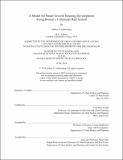A model for smart growth housing development along Boston's commuter rail system
Author(s)
Schlossberg, Jeffrey S
DownloadFull printable version (17.03Mb)
Other Contributors
Massachusetts Institute of Technology. Department of Urban Studies and Planning.
Advisor
Eran Ben-Joseph.
Terms of use
Metadata
Show full item recordAbstract
Massachusetts and the Boston metro area benefit from a diverse and thriving economy. However, the metro area's cost of living, and housing prices in particular, are among the highest in the nation. Housing supply will not keep pace with forecasted demand over the next several decades, which will substantially reduce expected population and economic growth. In addition, the region is expected to see a shift in demand from single-family homes to multifamily apartments as younger people enter the workforce and look for housing in urban areas. If the region's housing stock does not adapt and provide the types of housing as well as the needed quantity, companies and individuals are likely to leave the area for regions with lower costs of living and easier access to housing. Fortunately, the Boston metro area has one of the most expansive commuter rail systems in the country. Many of the system's station areas are underutilized and have the potential to accommodate more units of housing if smart growth policies are implemented and development occurs. These station areas represent a future source of land area for transit-oriented development that few other regions can match. This thesis estimates the current supply of housing along the commuter rail system and estimates how much additional supply could be accommodated if municipalities pursued smart growth policies, like Chapter 40R, that encourage transit-oriented development near commuter rail stations. Recognizing that zoning changes and development are slow processes, this thesis also proposes a model for prioritizing what specific stations are most suitable for new housing development and most appropriate for smart growth advocates and housing developers to focus their zoning and development efforts.
Description
Thesis: M.C.P., Massachusetts Institute of Technology, Department of Urban Studies and Planning, 2018. This electronic version was submitted by the student author. The certified thesis is available in the Institute Archives and Special Collections. Cataloged from student-submitted PDF version of thesis. Includes bibliographical references (pages 87-89).
Date issued
2018Department
Massachusetts Institute of Technology. Department of Urban Studies and PlanningPublisher
Massachusetts Institute of Technology
Keywords
Urban Studies and Planning.